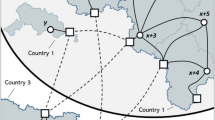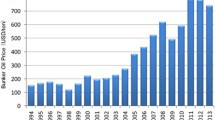Abstract
The Short Sea Shipping (SSS) market is strongly diversified, due to the variety of cargoes, vessel types and capacity, and segmented due to the existence of many national and peripheral submarkets. It is observed that prices differ considerably among transport services of similar distance routes and/or similar demand characteristics. The aim of this study is to identify factors influencing SSS operators pricing policies for both the sea and the inland part of intermodal chains, in an integrated framework. The analysis is based on the comparison of parameters influencing the cost structure and the pricing policy. The analysis of data collected through telephone and face-to-face interviews reveals that fuel, port cost, and market drivers with fuel cost being the most important elements influencing the variation in both the cost function and the pricing policy. Cost variations are also influenced by the cost of hinterland transport and the size of shipments, while pricing policy varies according to destination and type of goods transported. These findings contribute in understanding the SSS market and its operation. However, due to the complexity of self-organised systems, validating the presented cost and pricing structures remains a challenge.
Similar content being viewed by others
References
Amerini, G. (2008). Short Sea Shipping of goods 2000–2006. Statistics in focus—Transport, Eurostat.
Atenco (2001). Analysis of the cost structures of the main TEN ports. European Commission, Fourth Framework Research Programme.
Baccelli, O., Black, I., Seaton, R., Enei, R., & Schmid, S. (2001). Real cost reduction of door-to-door intermodal transport (Recordit). Annexes to part I. Task 2.1 methodology for the analysis of the mechanisms of cost and price formation in intermodal transport. Available at: http://www.recordit.org/deliverables.asp.
Baccelli, O., Cini, T., Vaghi, C., Zucchetti, R., Black, I., Seaton, R., et al. (2001). Real cost reduction of door-to-door intermodal transport (Recordit). Deliverable 2: Methodology of cost and price formation at corridor level. Available at: http://www.recordit.org/deliverables.asp.
Brooks, M. R., & Frost, J. D. (2004). Short Sea Shipping: A Canadian perspective. Maritime Policy and Management, 31(4), 393–407.
CEC (1995). Towards fair and efficient pricing in transport. Green Paper, COM(95) 691 final, Brussels.
CEU (1999). The development of Short Sea Shipping in Europe: A dynamic alternative in a sustainable transport chain. Second two-yearly progress report. COM (1999), 317 final, June 29. Brussels.
CEU (2001). European transport policy for 2010: Time to decide. White paper, Luxemburg.
CEU (2003). Programme for the promotion of Short Sea Shipping. COM (2003), 155 final, April 7. Brussels.
CEU (2006). Mid-term review of the programme for the promotion of Short Sea Shipping. COM (2006), 380 final, July 13. Brussels.
CEU (2006). Keep Europe moving, Mid-term review of the European Commission ‘2001 Transport White Paper. COM (2006), Brussels.
De Borger, B., Courcelle, C., & Swysen, D. (2004). Optimal pricing of transport externalities in an international environment: Some empirical results based on a numerical optimization model. Regional Science and Urban Economics, 34(2), 163–201.
ECMT (European Conference of Ministers of Transport) (2001). Short Sea Shipping in Europe. Paris: OECD.
Elliott, N. (2003). Med Sea change (pp. 72–75). Containerisation International.
European Parliament (1996). The common maritime policy—Chapter 1, maritime transport and the maritime industries. Available at: http://www.europarl.europa.eu/workingpapers/tran/w14/1_en.htm#(23).
EUROSTAT (2000). EU transport in figures. Statistical pocket book. Luxembourg: Office for Official Publications of the European Communities, July 2000. http://europa.eu.int/comm/transport/tif/tif_july2000.pdf.
Eurostat (2007). Panorama of transport. Statistical books. Luxembourg: Office for Official Publications of the European Communities.
Gibbons, E., & O’Mahony, M. (2002). External cost internalisation of urban transport: A case study of Dublin. Journal of Environmental Management, 64(4), 401–410.
Heaver, T. D. (1973). A theory of shipping conference pricing and policies. Maritime Policy and Management, 1(1), 17–30.
ITMMA (Institute of Transport and Maritime Management Antwerp) (2007). European Sea Ports Organisation (ESPO) Annual report 2006–2007—ITMMA Market Report. Published 31 May 2007 on the occasion of the ESPO 2007 Conference held in Algeciras, Spain.
Lindsay, A. (1998). European Marine Motorways (EMMA): The potential for transferring freight from road to high speed sea transport systems. Edinburgh: Napier University Business School.
Lloyd, M. (2003). Regional action for logistical integration of shipping across Europe (realise). Work package 4. Task 4.1 multi-modal pricing and costing analyses inception report.
Malakasi, E. M. (2007). Method for Distributing the flows of the SSS in the Mediterranean region. Unpublished MSc thesis. University of the Aegean, Department of Shipping, Trade and Transport, Chios.
Musso, E., & Marchese, U. (2002). Economics of shortsea shipping. In C. Th. Grammenos (Ed.), Handbook of maritime economics and business (pp. 280–304). London: Lloyd’s of London.
Nash, C., Sansom, T., & Still, B. (2001). Modifying transport prices to internalise externalities: Evidence from European case studies. Regional Science and Urban Economics, 31(4), 413–431.
National Ports and Waterways Institute, University of New Orleans. (2004). The public benefits of the Short-Sea Intermodal system. Prepared for the Short Sea Cooperative Program (SCOOP).
Nierat, P. (1992). Aire de marché des centres de transbordement rail-route: Pertinence de la théorie spatiale. In 6th World Conference on Transport Research, Lyon (12 p.).
Nitsopoulos, S. C., & Psaraftis, H. N. (2007). Short Sea Shipping in Mediterranean: Time for changes. 1st International Scientific Conference: Competitiveness and complementarity of transport modes—Perspectives for the development of intermodal transport. 10–12 May, Chios, Greece.
Notteboom, T. E. (2004). A carrier’s perspective on container network configuration at sea and on land. Journal of International Logistics and Trade, 1(2), 65–87.
Paixão, A. C., & Marlow, P. B. (2002). The strengths and weaknesses of Short Sea Shipping. Marine Policy, 26, 167–178.
Saurí, S. (2006). Cost structure in a short sea shipping line. Journal of Maritime Research, 3(2), 53–66.
Sys, C., Blauwens, G., Omey, E., Van de Voorde, E., & Witlox, F. (2008). In search of the link between ship size and operations. Transportation Planning and Technology, 31(4), 435–463.
Systema, S. A. (1999). Mediterranean Short Sea Shipping. Internal Report/Rev. 3. Work package 2.
Tsamboulas, D., & Kapros, S. (2000). The decision making process in intermodal transport. Transportation Research Record, 1707, 86–93. Washington DC.
Tsamboulas, D., Vrenken, H., & Lekka, A.-M. (2006). Assessment of a transport policy potential for intermodal mode shift on a European scale. Transportation Research Part A, 41, 715–733.
Vaggelas, G. K. (2007). Greek ports: Structural challenges and forms of adjustment. 3rd Hellenic Observatory PhD Symposium. 14–15 June, London, UK.
Vassallo, W., et al. (2004). Regional action for logistical integration of shipping across Europe (Realise). Available at: http://www.realise-sss.org.
Waals, F. (2005). Regional action for logistical integration of shipping across Europe. Final report on statistics. Deliverable 2.4: Final report.
Zachcial, M. (2001). Short Sea Shipping and intermodal transport. Prepared for European Conference of Ministers of Transport. Paris: OECD.
Zikmund, W. G. (2000). Business research methods (6th ed). Orlando: Dryden, Harcourt.
Author information
Authors and Affiliations
Corresponding author
Rights and permissions
About this article
Cite this article
Grosso, M., Lynce, AR., Silla, A. et al. Short Sea Shipping, intermodality and parameters influencing pricing policies: the Mediterranean case. Netnomics 11, 47–67 (2010). https://doi.org/10.1007/s11066-009-9039-0
Received:
Accepted:
Published:
Issue Date:
DOI: https://doi.org/10.1007/s11066-009-9039-0




